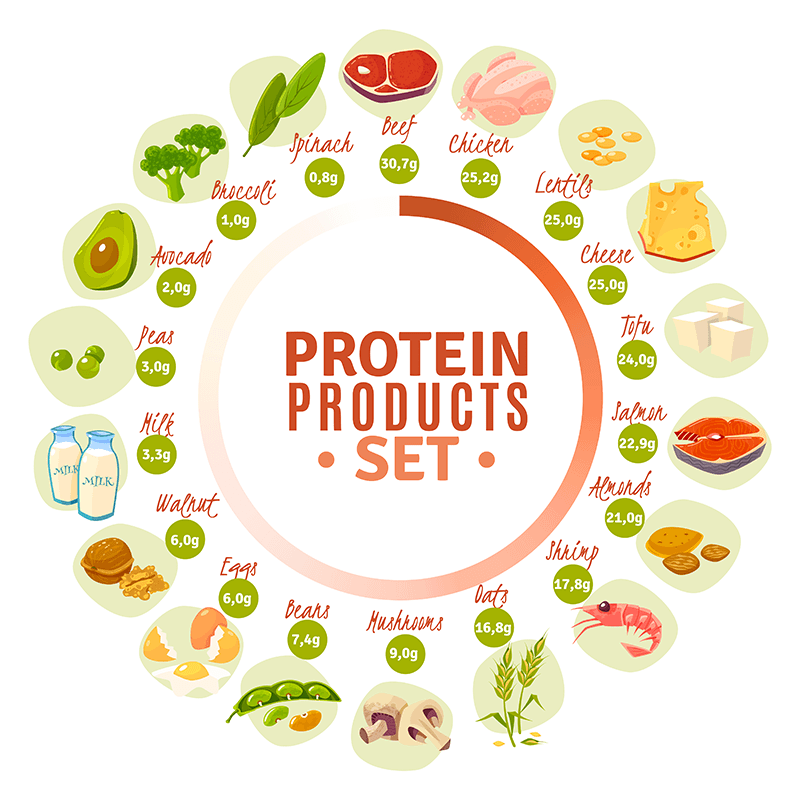Proteins are one of the building blocks of body tissue and play role in many body processes. They are formed by a combination of different amino acids.
When needed, proteins can be used as a secondary energy source and each gram of protein provides four calories. Our body use protein as an energy source through a process called gluconeogenesis. This process may occur when carbohydrate sources are not enough, in starvation or intense exercise.
In nature, there are hundreds of amino acids. However, only 20 of them can form proteins in living organisms and are called proteinogenic amino acids. Among these, the human body needs nine amino acids for proper functioning. These nine amino acids are called essential amino acids. They are phenylalanine, valine, threonine, tryptophan, methionine, leucine, isoleucine, lysine, and histidine. With these essential amino acids, the body can synthesize other required amino acids.
Complete vs incomplete proteins
Almost all foods of animal or plant origin contain proteins. However, these proteins’ amino acid structure and ratio may vary according to a food source. From a nutrition perspective, the term “complete proteins” defines food sources that contain every essential amino acid in adequate amounts. Animal foods such as dairy products, eggs, meats, poultry, seafood, and soy are complete protein sources.
You may heard the term “Incomplete proteins”. This term is used for protein sources that do not have enough of one or more of the essential amino acids. Most plant foods such as beans, grains, nuts, peas, seeds, and vegetables are incomplete protein sources. Incomplete protein sources can compensate for each other’s lack of amino acids when eaten in combination during the same day. When grains and legumes are eaten together, such as rice and beans or peanut butter on whole-wheat bread, they may form a complete protein.

What is the daily value for proteins?
In the US, the daily value for proteins is 50g for adults and 71g for pregnant & breastfeeding women. In addition to that, the recommendation is to get this amount by eating a variety of protein foods from both plant and animal sources. It is also advised to consume processed meats and poultry by only considering total calories, sodium, and saturated fat in the diet.
According to the FDA diets lower with meats, processed meats, and processed poultry are associated with a reduced risk of developing cardiovascular disease in adults. (FDA, 2021)(FDA, 2020)
What if you consume too much?
The World Health Organization (WHO) noted that current evidence suggests that total protein intake has little effect on cancer. However, some animal foods, such as red or processed meat, may increase cancer risk compared to vegetable protein sources. (WHO, 2002)
The International Agency for Research on Cancer (IARC) reported that consumption of red meat is “possibly carcinogenic to humans” (Group 2A), and consumption of processed meat causes colorectal cancer and classifies it as a “human carcinogen” (Group 1) (IARC, 2018)
References
* International Agency for Research on Cancer (IARC), 2018, IARC Monographs Vol 114 – Red Meat and Processed Meat
* World Health Organization (WHO), 2002, Protein and Amino Acid Requirements in Human Nutrition
* U.S. Food & Drug Administration (FDA), 2021, Protein, Accessed at: 07.01.21, Accessed from: https: //www.accessdata.fda.gov/scripts/InteractiveNutritionFactsLabel/assets/InteractiveNFL_Protein_March2020.pdf
* U.S. Food & Drug Administration (FDA), 2020, Nutrition labeling of food, Accessed from: https://www.accessdata.fda.gov/scripts/cdrh/cfdocs/cfcfr/cfrsearch.cfm?fr=101.9, Accessed at: 11.02.21
Do you want to follow your Protein Intake? You can do it for FREE. DOWNLOAD Itsmyfood by clicking here.

